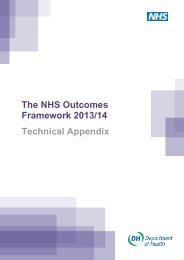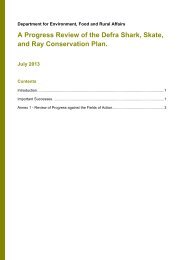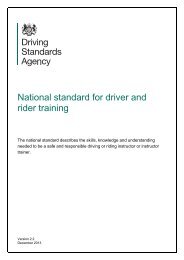Decontamination in primary care dental practices - Gov.uk
Decontamination in primary care dental practices - Gov.uk
Decontamination in primary care dental practices - Gov.uk
Create successful ePaper yourself
Turn your PDF publications into a flip-book with our unique Google optimized e-Paper software.
1 Policy and foreword (Barry Cockcroft, Chief Dental Officer)of a <strong>dental</strong> service is capable of operat<strong>in</strong>g <strong>in</strong> asafe and responsible manner with respect todecontam<strong>in</strong>ation of <strong>in</strong>struments and <strong>dental</strong>equipment. Where new <strong>practices</strong> arecommissioned or new premises contemplated, itis advised that the full best practice provisions ofthis guidance be utilised wherever reasonablypracticable.1.4 The guidance provided here follows the essentialpr<strong>in</strong>ciples given <strong>in</strong> the ‘Health and Social CareAct 2008: Code of Practice on the prevention andcontrol of health<strong>care</strong> associated <strong>in</strong>fections andrelated guidance’ (the Code of Practice). Thisrequires that effective prevention and control ofhealth<strong>care</strong>-associated <strong>in</strong>fection be embedded <strong>in</strong>everyday practice. For this reason, the guidance iswritten with emphasis on practical and readilyimplemented measures. Appendix B of the Code ofPractice refers specifically to the requirements for<strong>dental</strong> <strong>practices</strong>.1.5 The 2010 revision to the Code of Practiceestablishes a duty to provide and ma<strong>in</strong>ta<strong>in</strong> aclean and appropriate environment for health<strong>care</strong>with<strong>in</strong> which a specific requirement for effectivearrangements for the appropriate decontam<strong>in</strong>ationof <strong>in</strong>struments and other equipment is given.This guidance is designed to assist all <strong>primary</strong> <strong>care</strong><strong>dental</strong> providers (<strong>in</strong>clud<strong>in</strong>g salaried <strong>dental</strong> services)<strong>in</strong> meet<strong>in</strong>g these requirements.1.6 ‘Clean, safe <strong>care</strong> – reduc<strong>in</strong>g <strong>in</strong>fections andsav<strong>in</strong>g lives’ refers to the need for high-qualityenvironmental clean<strong>in</strong>g and decontam<strong>in</strong>ation asvital components <strong>in</strong> reduc<strong>in</strong>g rates of <strong>in</strong>fection.“Essential quality requirements” and“best practice”1.7 Every practice should be capable of meet<strong>in</strong>g theessential quality requirements, that is:• Regardless of the technology used, the cleaned<strong>in</strong>struments, prior to sterilization, should befree of visible contam<strong>in</strong>ants when <strong>in</strong>spected.Instruments should be reprocessed us<strong>in</strong>g avalidated decontam<strong>in</strong>ation cycle <strong>in</strong>clud<strong>in</strong>g:clean<strong>in</strong>g/wash<strong>in</strong>g (<strong>in</strong> terms of manual clean<strong>in</strong>g,this <strong>in</strong>cludes hav<strong>in</strong>g a written protocol – seeChapter 16); a validated steam sterilizer, and atthe end of the reprocess<strong>in</strong>g cycle they should be<strong>in</strong> a sterilized state.• Reprocessed <strong>dental</strong> <strong>in</strong>struments should bestored <strong>in</strong> such a way as to ensure restra<strong>in</strong>t ofmicrobiological recolonisation. These measuresshould be backed by <strong>care</strong>ful controls on thestorage times to which <strong>in</strong>struments that are lessfrequently used are subject.• Practices should audit their decontam<strong>in</strong>ationprocesses every six months us<strong>in</strong>g an audit tool(the use of the Infection Prevention Society/DHaudit tool is strongly recommended). This canbe downloaded from www.ips.<strong>uk</strong>.net at the“resources/<strong>dental</strong> audit tool” section of thewebsite.• Practices should have <strong>in</strong> place a detailed plan onhow the provision of decontam<strong>in</strong>ation serviceswill move towards best practice.An expanded list of essential quality requirementsis given <strong>in</strong> paragraph 2.4.1.8 To demonstrate best practice, furtherimprovements are required <strong>in</strong> three ma<strong>in</strong> areas:• A clean<strong>in</strong>g process that should be carried outus<strong>in</strong>g a validated automated washer-dis<strong>in</strong>fector.• The environment <strong>in</strong> which decontam<strong>in</strong>ation iscarried out should be such as to m<strong>in</strong>imise therisk of recontam<strong>in</strong>ation of <strong>in</strong>struments and thepossibility of generat<strong>in</strong>g aerosols, which mayreach patients or unprotected staff. For bestpractice, the decontam<strong>in</strong>ation facilities shouldbe clearly separate from the cl<strong>in</strong>ical treatmentarea. This implies the use of a separate room orrooms for the accommodation of clean (output)and dirty (<strong>in</strong>put) work. In these facilities, theroom(s) should be used for this purpose onlyand access should be restricted to those staffperform<strong>in</strong>g decontam<strong>in</strong>ation duties. However,plant and equipment not necessarily used fordecontam<strong>in</strong>ation may be located <strong>in</strong> these rooms(but preferably <strong>in</strong> the dirty room) provided itcan reasonably be shown that the devices donot conflict with the requirement for a cleanenvironment.• The storage of reprocessed <strong>dental</strong> <strong>in</strong>struments<strong>in</strong> a simple but <strong>care</strong>fully designed facility clearlyseparate from the cl<strong>in</strong>ical treatment area is animportant best practice improvement. Thefacility should take account of the need toreduce recontam<strong>in</strong>ation of sterilized <strong>in</strong>strumentsand also make the identification/selection of3
















